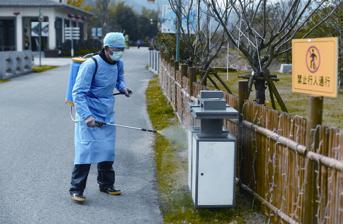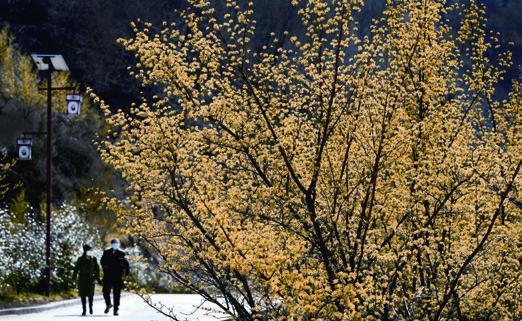Delayed Spring
2020-03-19ByWangJun
By Wang Jun


Xu Ting, a nurse living in Beijing, had planned a trip to Iceland with her friend in February to watch the northern lights. They booked their tickets during the Double 11 sales promotion in November 2019 and also paid a local travel agency in Iceland for a six-day tour.
But on January 31, the carrier, Scandinavian Airlines (SAS), announced it was canceling all flights to and from the Chinese mainland till February 10 due to the novel coronavirus epidemic, and later extended the cancelation to April 30. So did most foreign airlines.
Xu and her friend had to cancel their travel plan. Though they got a full refund on the air tickets, they lost 50 percent of the money paid for the local tour.
“My family also urged me to cancel the trip as they were concerned there could be discrimination against Chinese in foreign countries. Besides, there was the governments policy that people returning to Beijing from outside would have to be quarantined for 14 days,” the 35-year-old told Beijing Review.
According to figures released on February 4 by Ctrip, a leading online travel agency, it had refunded all group tours, travel packages and tailor-made travel bookings as well as most of the bookings for air and train tickets and hotels up to February 29. The number of refunded transactions ran into several million.
Falling off a cliff
This happened at a time when the tourism market has been growing exponentially during the Spring Festival holiday. According to the China Tourism Academy (CTA), during the holiday in 2019, China estimatedly received 415 million tourist visits, up by 7.6 percent on the previous year. They generated revenues of 513.9 billion yuan ($74.16 billion), an 8.2-percent rise year on year.
This year, Spring Festival, the Chinese New Year, fell on January 25. However, according to figures from the Ministry of Transport, from January 10 to 31, the number of passengers traveling by train, road, water and air totaled 1.26 billion, a drop of 20.6 percent from a year ago. Water travelers took the biggest hit, 34 percent, followed by passengers by road (22.1 percent), air (14.4 percent) and train (10.7 percent).
Based on the past three years statistics, Zeng Fanwen, Executive Director of the Cultural Industries Institute of Renmin University of China, had predicted that the number of tourists during the Spring Festival holiday would be 450 million and total tourism revenue 550 billion yuan ($79.37 billion), according to an International Business Daily report. But due to the outbreak, the estimates will now fall wide off the mark.
The CTA forecasts that in the fi rst quarter of 2020, the number of domestic tourists may decrease by 56 percent, and total tourism revenues slump by 69 percent.

“Viewing it optimistically, the tourism revenues may reduce by 60 percent within the f irst three months after the outbreak and 30 percent in the following three months during the recovery. Throughout this year, Chinas travel industry is expected to lose around 3 trillion yuan ($432.9 billion),” Wu Bihu, head of the Recreation and Tourism Research Center at Peking University, told 21st Century Business Herald.
Staged recovery
Tourist sites should reopen following the principle of taking differentiated measures. Reopening of tourist attractions in high-risk regions should be postponed, while resumption of those in medium- and low-risk regions can be decided by the local governments, Liu Kezhi, Director of the Market Administration of the Ministry of Culture and Tourism, said at a press conference in Beijing last month.
“The epidemic seriously hurt the travel industry. The desire to recover as soon as possible is understandable, but it is still too early for the travel industry to reopen,”Zhang Hui, Vice President of the Beijing Tourism Society, said in an interview with China Youth Daily.
Zhang said resumption of the travel industry should be carried out in a staggered way. For instance, outdoor and natural scenic spots can be reopened fi rst, and the indoor and cultural ones later. Self-drive tours may resume earlier, while group tours may resume more slowly. Short-distance travels may resume faster than medium- and longdistance travels, while it will take even longer for inbound travels to recover.

Rebound likely
“The market fundamentals supporting the development of the tourism industry have not changed, so it is very likely that domestic tourism consumption will rebound,” Dai Bin, President of the CTA, told China News Service. He said a survey among urban and rural residents showed that 71.5 percent of those surveyed will travel after a certain period of time when the epidemic ends, and 20.7 percent will travel as soon as possible once the epidemic is over.
Peoples Daily quoted Sun Jie, CEO of Ctrip, as saying the millions of orders for refund or change the company has handled dont mean they are canceled, but merely postponed. As long as the user experience is ensured and peoples spending capability remains, they will come back after the epidemic comes to an end.
Zhou Xiangzhi, head of the think tank office of the Hunan Academy of Social Sciences, said in an article in Guangming Daily that people after having deeply experienced the ravages of the epidemic will appreciate the value of health and life more and more, and their personal values, lifestyles and consumption patterns will change. To satisfy the changing demand of the public, cultural and tourism businesses can develop more special tourism products of higher quality featuring health, sports and school excursions.
Zhou also suggested that cultural and tourism businesses take the opportunity of industrial upgrading brought by the epidemic to introduce new technologies such as big data and artifi cial intelligence to improve their corporate operation effi ciency.
After the end of the severe acute respiratory syndrome in 2003, consumption bounded back remarkably. In 2004, tourism revenues surged by 40 percent over 2003, according to Zeng Bowei, head of the China Center for Tourism Economy and Policy Studies affi liated to Beijing Union University, in an interview with China Youth Daily.
“The size of the middle- and high-income group in China keeps growing. Although they still face pressure in education, healthcare and housing, the consumption power for travel in most of this group still exists,” Zeng said, predicting that the tourism rebound will be particularly remarkable in October, when there is a week-long national holiday.
Xu still plans to travel abroad this year but only after all safety concerns are removed, particularly following the explosive growth of the virus in countries like Italy and the Republic of Korea.
“I will make new travel arrangements but only after making sure that the epidemic has been completely eliminated,” she told Beijing Review.
